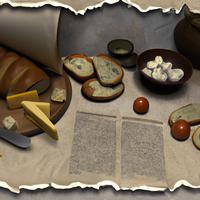
1 serving (100 grams) contains 265 calories, 11.0 grams of protein, 10.0 grams of fat, and 35.0 grams of carbohydrates.

Log this food in SnapCalorie

Nutrition Information
Calories |
637.0 | ||
|---|---|---|---|
% Daily Value* |
|||
| Total Fat | 24.0 g | 30% | |
| Saturated Fat | 14.4 g | 72% | |
| Polyunsaturated Fat | 0 g | ||
| Cholesterol | 48.1 mg | 16% | |
| Sodium | 961.5 mg | 41% | |
| Total Carbohydrates | 84.1 g | 30% | |
| Dietary Fiber | 4.8 g | 17% | |
| Sugars | 7.2 g | ||
| protein | 26.4 g | 52% | |
| Vitamin D | 0 mcg | 0% | |
| Calcium | 360.6 mg | 27% | |
| Iron | 4.8 mg | 26% | |
| Potassium | 288.5 mg | 6% | |
* Percent Daily Values are based on a 2,000 calorie diet. Your daily values may be higher or lower depending on your calorie needs.
Food Attributes
Source of Calories
About Bread with fresh cheese
Bread with fresh cheese is a simple and wholesome pairing enjoyed across various cuisines worldwide. Typically, it features crusty bread, such as sourdough or whole-grain varieties, served with soft, fresh cheese like ricotta, cottage cheese, or farmer’s cheese. Originating from rustic traditions, this combination is popular in Mediterranean, European, and Middle Eastern diets. Nutritionally, the dish provides a balanced mix of carbohydrates, protein, and calcium. Whole-grain bread adds fiber and supports digestive health, while fresh cheese delivers essential nutrients like calcium, phosphorus, and B vitamins, promoting bone health and muscle function. However, some cheeses may contain higher amounts of saturated fat and sodium, so moderation and selecting lower-fat options are key. Pairing this with fruits, herbs, or olive oil can enhance flavor and nutrient density, making it a versatile and satisfying choice for breakfast or snacks.



